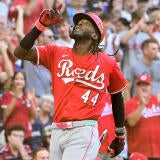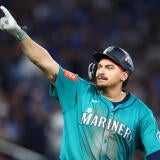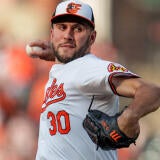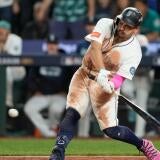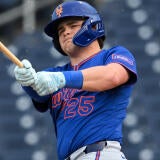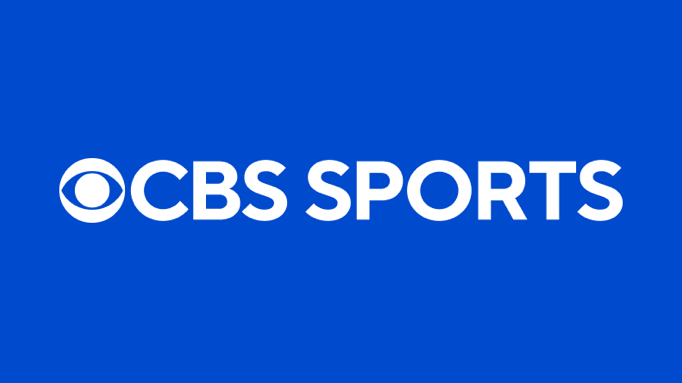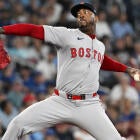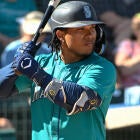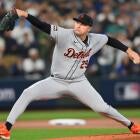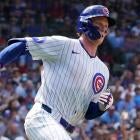Fantasy Baseball: Everything you missed once Fantasy Football began, from unlikely risers to prospect call-ups
You may have tuned out, but the season kept going
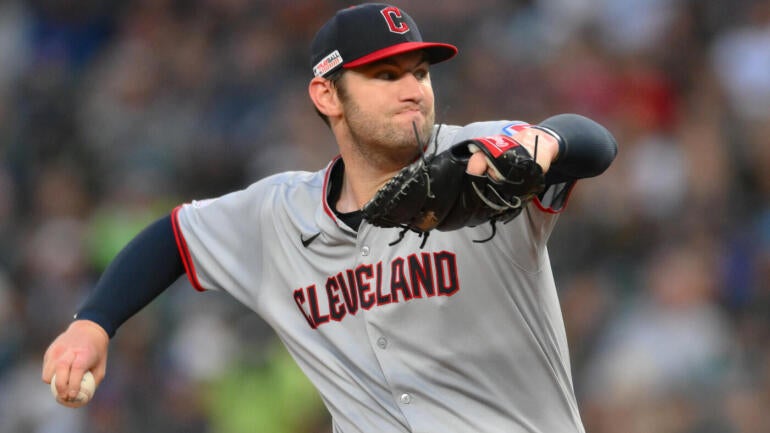
I know you. Always looking for the next distraction. "Oh, Fantasy Football is gearing up again. I guess I should be giving that all of my attention."
You think baseball goes on pause in the meantime? It doesn't. No matter how badly you messed up your Fantasy team, those players keep accumulating numbers, as do all the others, and if you think they accumulate them at the same rate they already were, you are tragically mistaken. Depending on when you tuned out exactly -- as early as August for some -- you'll be greeted by a very different landscape when Fantasy Baseball becomes the new distraction next March.
But fear not. I'm here to cater to your fleeting attention span, recapping all the most notable Fantasy Baseball developments from the final two months of the 2025 season.
I will warn you: It is long, but it is critically important. So buckle up and drink it in.
Players who gained the most
- You probably know Emmet Sheehan to be a pitcher of some promise, but what you missed was him making good on that promise in spectacular fashion. The line between starts and relief appearances is blurred for him, given the Dodgers' frequent use of openers, but in four of the final six outings in which he was the bulk pitcher, he lasted six innings or more, going seven innings in three of them. And he backed it up with his performance, putting together a 1.93 ERA, 0.72 WHIP and 11.8 K/9, along with a 19 percent swinging-strike rate that would have tied the record for highest ever by a qualifying starting pitcher (Spencer Strider in 2023). I'd say the promise has been fulfilled.
- If you haven't heard of Jakob Marsee, you were like most everyone else when the Marlins called him up on Aug. 1. He had some interesting minor league numbers and got a moment of notoriety when the Padres included him in the Luis Arraez trade last year, but he never projected to be an impact player. That's exactly what he became, though, batting .292 with five homers, 14 steals and an .842 OPS in 55 games. His August was much better than his September, but on balance, his 3.33 Head-to-Head points per game were the 13th-most among all outfielders in 2025.
- Nolan McLean was the least hyped of the Mets' three starting pitcher call-ups (more on the other two later), but he arrived the earliest and made the biggest impact, going 5-1 with a 2.06 ERA, 1.04 WHIP and 10.7 K/9 in eight starts. His swinging-strike rate was nothing to write home about, but his 61.1 percent ground ball rate would have ranked second among qualifiers.
- Yet another New York call-up who somehow wasn't hyped enough, Cam Schlittler claimed a spot in the Yankees rotation just before the All-Star break, which you may remember. He didn't really find his footing until mid-August, though, going on to deliver a 2.23 ERA, 0.99 WHIP and 11.2 K/9 in his final nine starts, with five of them lasting six innings or more. The key to his arsenal was a four-seamer that averaged 98.0 mph, trailing only Hunter Greene, Jacob Misiorowski and Paul Skenes among starting pitchers with at least 65 innings.
- Brice Turang was, of course, known to you already, but probably as a slap-hitting speedster. If you ever ventured over to his Baseball Savant page, though, you would have noticed that his exit velocity readings, both average and max, had improved by about 4 mph from the year before. That put him in the upper 25-30 percent of the league for contact quality, making power hitting possible, and he delivered on it finally in August, hitting 10 of his 18 home runs overall. Seeing as he also has a 50-steal season in his past, the upside here is much higher than anyone realized.
- Though a trendy breakout pick coming into the year, Gavin Williams probably left a bad taste in your mouth with his first-half performance, but he went on to deliver a 2.18 ERA, 1.05 WHIP and 10.0 K/9 in the second half and, in particular, turned the corner over his final five starts with a 1.74 ERA, 1.06 WHIP and 11.0 K//9. He had a 66 percent strike rate and 14 percent swinging-strike rate in those five starts compared to 61 percent and 11 percent previously.
- To the degree you knew Hurston Waldrep, he was a former prospect who had fallen out of favor with his miserable 2024 and subsequent minor league struggles. But the 23-year-old put together a really nice run for a resurgent Braves team and likely has a leg up for a rotation spot entering 2026. There were some control issues, but he allowed one earned run or fewer in seven of his 10 outings for a 2.88 ERA, having broadened out his arsenal with a new sinker and cutter.
- One of the most amazing statistics of the entire second half was rookie Cade Horton's 1.03 ERA in 12 starts. Those starts were mostly on the shorter side, with him averaging just 7.9 K/9 between them, but he also threw strikes and induced tons of weak contact in the air. He certainly overperformed to an extent, but there's also untapped upside, judging from the whiff rates on his (underutilized) secondary pitches. Definitely an interesting case for 2026.
- Few may have heard of Jakob Marsee prior to his August promotion, but I'll admit that even I hadn't heard of Daylen Lile until a couple weeks after that, by which point he had already become a fixture in the Nationals lineup. It was in September, though, that he showed he might have something to offer in Fantasy, hitting .391 (36 for 92) with six homers, seven triples, three doubles and a 1.212 OPS. His profile isn't the safest for Fantasy since his power outlook is questionable, but he makes contact at a nice rate and could learn to make better use of his 92nd percentile sprint speed.
- To the degree you may have thought about Lenyn Sosa, it was along the lines of "how long before the White Sox find someone to replace this guy?" Hopefully not for a while, because he seems like a pretty handy player after hitting 13 home runs in his final 50 games. He's no stud in the making or anything, and his low walk rate may prevent him from ever amounting to much in points leagues, but Statcast suggests he deserved even better than his .264 batting average and .434 slugging percentage for the year, with his .275 xBA and .484 xSLG both ranking in the upper quarter of the league.
- Shane Smith generated some interest early in the year, but you probably figured we were done with him when he put together a 7.28 ERA in June and July. Fortunately, there was also an August and September, and in his final 10 starts, he had a 3.09 ERA, 1.01 WHIP and 9.8 K/9. Suffice it to say there will be renewed interest in him in 2026.
Others who came on strong
- Kyle Bradish and Shane Bieber both returned from Tommy John surgery looking more or less like the high-end pitchers they were before it. That's especially true for Bradish, who put together a 2.53 ERA, 1.03 WHIP and 13.2 K/9 in six starts. Bieber retained his velocity gains from the work he did with Driveline Baseball prior to the 2024 season, but he missed bats at a lower rate than Bradish, putting together a 3.57 ERA, 1.02 WHIP and 8.3 K/9 in his seven starts. They'll both surely be among the top 36 starting pitchers drafted in 2025.
- You may have already chalked up George Springer's season as a success at the time you tuned out, seeing as he was having some sort of impact after a 2024 season in which he appeared to age out of Fantasy relevance, but you have no idea how good it became. He hit .369 with a 1.121 OPS in the second half, showing not just that he has more left in the tank at age 35 but also that he's as good as he's ever been, ranking as the fifth-best outfielder in Head-to-Head points per game for the season.
- While Springer was hitting .369 in the second half, Bo Bichette was hitting .370, bringing his full-season stat line in agreement with where we're used to seeing it. He has now hit .290 or better with an OPS over .800 in every year but one.
- Seeing as he was having to build up on the fly since the Dodgers, on account of his bat, couldn't exactly send him on a rehab assignment, you may wonder if Shohei Ohtani ever got stretched out enough to amount to something as a pitcher, and the answer is ... yes. Three of his final four outings saw him go five innings or more with just one earned run between them for a 0.46 ERA, 0.71 WHIP and 12.4 K/9. He broke out a curveball to go with his already deep arsenal of swing-and-miss pitches and had a 14.2 percent swinging-strike rate overall. There are no superlatives great enough.
- In the Year of the Catcher, Gabriel Moreno wasn't willing to forfeit the spotlight. He returned from a fractured finger in late August looking better than ever, mostly on account of him finally elevating the ball to tap into his latent power. He hit .311 (32 for 103) with four homers and an .863 OPS in those 30 games, putting him in the top-12 discussion at the hottest position.
- When last you looked, Kevin Gausman may have seemed like he was barely hanging on as a Fantasy asset, but he was a genuine ace in the second half, going seven innings or more in six of his 13 starts for a 2.81 ERA, 0.94 WHIP and 9.2 K/9. His 69 percent strike rate and 13 percent swinging-strike rate during that time were both elite, and his splitter seemed to regain the vertical break it lost in 2024. Prudence is warranted for a player in his mid-30s, but you should expect him to go fairly high in drafts.
Concerning developments
- Perhaps the most devastating injury of the season was one you may have missed if you had your nose elsewhere. Zack Wheeler, who appeared to be on track for his first Cy Young award, was diagnosed with a blood clot in his right shoulder in mid-August and prescribed thoracic outlet surgery about a week later. His thoracic outlet surgery, which was intended to decompress a vein in his shoulder, generally has more favorable outcomes than the type that Matt Harvey had, which was intended to alleviate a nerve. It still introduces significant risk for a pitcher in his late 30s and could end up sidelining Wheeler for the first couple months of 2026.
- I'm obliged to point out that Oneil Cruz hit .140 (16 for 114) with two homers and a .462 OPS over his final 37 games, but really, things went off the rails for him much earlier than that. From May 1 on, he hit .185 (69 for 372) with a .614 OPS. It's just that his April was so productive that it took a while for us to notice how bad the situation had gotten. The biggest underlying change is that he began hitting the ball on the ground more, and between that and his bloated strikeout rate ... woof.
- Elly De La Cruz and Oneil Cruz are so often linked for a variety of reasons, and unfortunately, one of those reasons is that they were both terrible for the final two months of 2025. De La Cruz wasn't quite as bad, batting .221 (46 for 208) with three homers and a .621 OPS, and there may be a clearer explanation for his struggles in that he was playing through a quad injury, which manager Terry Francona revealed in August. I still expect him to be drafted in Round 1 next year, at least in leagues that use standard 5x5 scoring, while Cruz, minus the "De La," could see his draft stock plummet.
- Kodai Senga has been regarded as a Fantasy standout since he had a 2.98 ERA and 202 strikeouts as a rookie in 2023, and if you just glance at his 3.02 ERA to end 2025, you'll assume everything was hunky-dory then as well. Remember, though, he had a 1.47 ERA when he strained his hamstring in mid-June. It seemed unsustainable, but whatever, we were all having too good of a time to care. Thing is, he was so bad after returning from the hamstring injury that he had to be sent to the minors twice. He had a 5.90 ERA and 1.69 WHIP in his final nine major league starts, issuing 5.4 BB/9, and his numbers in the minors, to the degree that he pitched there, weren't much better. It's hard to say what kind of future he has in the majors at this point -- which isn't to say he has none, but what does it look like?
- If the season had ended a week earlier, Ozzie Albies would have slotted into the "sighs of relief" category (see below). He was batting .272 (65 for 239) with nine homers, seven steals and a .769 OPS in the second half, looking every bit like the Albies we remember, and a report came out during that time that confirmed his earlier struggles were related to the fractured wrist he suffered in 2024. So all seemed well ... and then he broke the hamate bone in his left hand Sept. 22. That fracture is notorious for sapping hitters' power, sometimes for months after they return. It's not a universal trait, so maybe Albies will be no worse for wear when he reports next spring. But capping off an already tumultuous season with such an injury is sure to invite great skepticism in 2026.
- At the point when you logged off, Framber Valdez probably seemed as bankable as aces get, putting together a 2.62 ERA, 1.11 WHIP and 9.5 K/9 through the first four months. Unfortunately, he then had a 6.05 ERA, 1.55 WHIP and 7.1 K/9 in the two months that followed, struggling with a curveball that's increasingly become a make-or-break pitch for him. He did rediscover it in his final start, allowing one run while striking out 10 over seven innings, which should relieve concerns that he's simply lost it. Between that and his extended track record, you shouldn't expect too much of a Draft Day discount for Valdez.
- My concerns for Shota Imanaga are more significant. From the start of 2025, the 32-year-old wasn't missing bats at nearly the same rate he did during his surprising rookie season, and his already high fly ball rate had sharply increased. But because he carried an ERA as low as 3.08 all the way through August, it didn't raise much alarm. Only in his final six starts did his vulnerability to the long ball come home to roost. He allowed 12 home runs during that time for a rate of 3.1 per nine innings, which is double what would be considered a high rate. His ERA in those six starts was 5.97, raising his season mark to 3.73.
- If you're wondering why not everyone in the Fantasy Baseball orbit is moving heaven and earth to draft Eury Perez, who seemed to be back on an ace trajectory 10 starts into his return from Tommy John surgery, it's because things went kind of sideways in the 10 starts thereafter. He still missed bats at a terrific rate, but he had a 5.96 ERA, mostly by way of the long ball. There were some indications that he may have been tipping his pitches during this time, but those remain unconfirmed.
- Evidence of Mike Trout's decline, which had been obscured by injuries in recent years, had already been substantiated by the time you tuned out, but it became all the more glaring down the stretch, with his strikeout rate going from a manageable 26.8 percent in the first half to an untenable 38.1 percent in the second half. The last time a qualifying batter had a strikeout rate as high as 38.1 percent for a full season was ... well, never.
- Yeah, Rafael Devers began the year 0 for 19 with 15 strikeouts, but everything was fine thereafter, right? Actually, May was the only month when he had a strikeout rate lower than 27 percent, which is notable for a player whose best years saw him strike out less than 20 percent of the time. The effect on his batting average was palpable. He hit just .236 during his 3 1/2 months with the Giants. His home run output remained excellent during that time, which would have seemed like the biggest concern for a left-handed hitter going to Oracle Park, but the escalating strikeout rate combined with the downward park shift has me more worried about Devers' capacity for batting average moving forward.
- You may have thought things were trending up for Sean Manaea when your attention shifted elsewhere, because for his first month back from an oblique injury, they were. His four outings were on the shorter side, but he had a 2.08 ERA, 0.87 WHIP and 11.4 K/9 between them, continuing the outrageous success of the lower arm angle he introduced late in 2024. But he was dreadful in 11 appearances thereafter, putting together a 7.06 ERA, 1.36 WHIP and ... well, 11.0 K/9. Yeah, the strikeouts and walks remained great, which gives me some hope for him moving forward, but he got knocked around every time he took the mound. Not even a shift to the bullpen late in the year could correct it.
Sighs of relief
- Don't be fooled by Sandy Alcantara's full-season 5.36 ERA, which is so bad that it might convince you nothing changed for him down the stretch, but something did. He was every bit the front-line starter we knew him to be prior to Tommy John surgery, throwing 6-7 innings in each of his final eight starts for a 2.68 ERA, 0.86 WHIP and 8.7 K/9. He threw 71 percent of his pitches for strikes during that stretch compared to 64 percent previously. His swinging-strike rate was 11 percent compared to 9 percent previously, and his ground ball rate was 49 percent compared to 46 percent previously. He's back, baby!
- There was no salvaging Jackson Merrill's sophomore season, which was plagued by injuries from the start, but the consensus third-round pick coming into the year did what he could to improve his 2026 standing in September, homering seven times in his final 20 games.
- You may have seen the first signs of Michael Harris turning his disastrous season around, which began immediately after the All-Star break, and I'm pleased to report that it more or less continued through season's end, with some peaks and valleys along the way. His .299 batting average, 14 homers, eight steals and .845 OPS in the second half were about in line with our greatest hopes for him, and he went on to deliver his first ever 20/20 campaign.
- Other outfielders who disappointed overall but enjoyed second-half turnarounds include Bryan Reynolds (a .225 batting average and .656 OPS in the first half compared to .276 and .816 in the second) and Brenton Doyle (a .202 batting average and .576 OPS in the first half compared to .287 and .779 in the second).
- For the first four months, Mookie Betts seemed like a shell of his former self, and the only question was whether to blame it on his early-season stomach illness or his 32 years of age. But he basically righted the ship in his final 47 games, batting .317 (59 for 186) with nine home runs, an .892 OPS and more walks (19) than strikeouts (17). The most telling part was that his average exit velocity was 90.7 mph during that time, similar to his prime years, compared to 88.3 mph previously.
- Another aging Dodgers hitter who struggled to deliver his former power numbers most of the year was Freddie Freeman, but he likewise turned things around over the final two months, hitting 13 of his 24 home runs.
- If you thought Jurickson Profar's PED suspension was the final word on his breakthrough 2024, then you obviously missed his massive August in which he slashed .295/.428/.598 with nine home runs. He ended the year in a 3-for-29 slump, which dragged down his batting average a bit, but his 3.46 Head-to-Head points per game placed ninth among outfielders in 2025, which was even higher than in 2024.
- An early-season shoulder injury limited Spencer Steer to DH duties and likely hindered his production, but he was basically the player we always knew him to be from May 1 on, batting .252 with 19 homers and a .767 OPS. He was in such an early hole statistically, though, that his turnaround didn't become clear until the end of the year, when a late surge saw him finish with a better batting average (.238), home run total (21) and OPS (.723) than in 2024. He didn't run as much, which may also be why his 2025 felt like such a disappointment, but his sprint speed rated similarly, making a return to the 20-steal threshold next year a possibility.
- While it's technically true that Jesus Luzardo had a 10-start stretch midseason in which he delivered an 8.04 ERA, most of the blame for that falls on the first two of those starts, when he was confirmed to be tipping his pitches and allowed 20 earned runs in 5 2/3 innings. Because he was still a little shaky in the eight starts that followed, though, the whole episode probably left a bad taste in your mouth. Well, I'm pleased to report that he redeemed himself over his final 11 starts, delivering a 2.84 ERA, 0.88 WHIP and 10.3 K/9. And if you remove just the two starts when he was tipping his pitches, his season numbers look pretty similar: a 3.03 ERA, 1.11 WHIP and 10.6 K/9.
- There were signs of Christian Walker turning his season around as early as July, but if you ducked out in August, you probably still came away with the impression that he doesn't have much left to offer at age 34. I'll have you know that more than half of his home runs, 14 of 27, came in August and September, and in all, he hit .264 with 17 homers and an .807 OPS in the final three months -- typical Walker numbers, truly. That's compared to .213 with 10 home runs and a .635 OPS in the first three months.
- You may not have taken note of Chris Sale's return from a fractured rib since it didn't happen until Aug. 30, but it happened and happened gloriously. He recorded exactly nine strikeouts in five of his six outings, putting together a 2.72 ERA, 0.83 WHIP and 12.6 K/9 and picking up right where he left off before the injury. In fact, from April 25 on, spanning 16 starts in all, he had a 1.76 ERA, 0.94 WHIP and 11.7 K/9. Don't be surprised if he's one of the first five starting pitchers drafted in 2026.
- Compared to Sale, Cole Ragans was out even longer (strained rotator cuff) and returned even later, but he likewise looked every bit like the ace we remembered in his three starts, putting together a 2.77 ERA, 0.77 WHIP and 15.2 K/9. That he ended the year with a 4.67 ERA is a fluke of happenstance, as his 2.63 xERA and 2.50 FIP demonstrate plainly enough.
- Jonathan Aranda, who was lost July 31 to a fractured wrist, only returned for the Rays' final series at the Blue Jays, but he still managed to put an exclamation point on his breakout season by going 4 for 12 with two home runs. He finished with a .316 batting average and .883 OPS.
- Turns out Zac Gallen wasn't entirely a lost cause. After putting together a 5.60 ERA, 1.35 WHIP and 8.6 K/9 over the first four months, he delivered a 3.32 ERA, 1.08 WHIP and 7.5 K/9 over the final two. He didn't throw strikes at a higher rate or miss any more bats, but he allowed weaker contact, with more of it coming on the ground.
Psych!
- If your last impression of Pete Crow-Armstrong was that he's an emerging MVP candidate with his superlative defense and massive home run and stolen base totals, yeah, you clearly tuned out for the final two months. He hit .188 with a .533 OPS during that time compared to .272 with an .868 previously, showing the volatility that's inherent to having such poor plate discipline.
- Ceddanne Rafaela has the same profile as Crow-Armstrong -- dynamic center fielder with playable power but modest exit velocities and a swings-at-anything approach -- so it's fitting that his 2025 played out much the same way. The highs weren't as high and the lows weren't as low, but after hitting .271 with 14 homers and a .796 OPS in the first half, he hit .218 with just two homers and a .587 OPS in the second half.
- Crow-Armstrong's collapse was so front-and-center that it overshadowed James Wood's. The Nationals standout, who also gave the appearance of a budding first-rounder with his first-half performance, crashed just as hard, going from hitting .294 with a .958 OPS in his first 87 games to .210 with a .660 OPS in his final 70. Perhaps even more concerning is that his strikeout rate jumped from 26.4 percent in that first stretch to 39.4 percent in the second.
- MacKenzie Gore was like the pitching equivalent of Wood, going from being a breakout ace in the first half with a 3.02 ERA, 1.20 WHIP and 11.3 K/9 to utterly unusable in the second half with a 6.75 ERA, 1.70 WHIP and 8.7 K/9. He may not even be one of the first 50 starting pitchers drafted in 2026.
- The Nationals' second-half misery continued with C.J. Abrams, who went from hitting .287 with an .836 OPS before the All-Star break to .217 with a .633 OPS afterward. His 2024 broke down similarly, and at a position as deep as shortstop, it doesn't take much of a misstep to send a player plummeting down the rankings.
- Called up in mid-June, Jacob Misiorowski became an immediate sensation, even making the All-Star team after just five starts. You probably remember him going on the IL with a bruised tibia in early August. You may even remember him having a bumpy return in mid-August. What could be news to you, though, is that the return didn't get any smoother thereafter. Five of his final eight appearances were less than five innings, making them virtually unusable in Fantasy, and considering he had a 6.06 ERA between them, we can probably blot out the "virtually." Walks were an issue, unsurprisingly, but his 11 percent swinging-strike rate during that time was shockingly ordinary for a pitcher with his stuff.
- Matthew Boyd and Andrew Abbott were two early-season successes who continued to defy expectations all the way to the end, right? The overall numbers might lead you to believe so, but things got pretty rocky for them late, with Boyd putting together a 5.66 ERA over his final eight starts and Abbott putting together a 4.95 ERA over his final seven. For Boyd, I can at least point out that his slider appeared to lose its bite during that time, but I'm not sure the explanation matters so much. Both were bound to regress -- it was right there in the ERA estimators -- and while I don't think either is as bad as his final two months, I also wouldn't value either by his full-season numbers.
- Robbie Ray and David Peterson were two other pitchers who finished the year much worse than they started it. Ray is particularly disappointing because he has ace upside, but between his extensive injury history and his 34 years of age, it would be hard not to take his 8.13 ERA and 1.77 WHIP over his final six starts as a warning sign. Peterson, on the other hand, was never widely embraced in Fantasy due to his poor strikeout rates and shaky control, so in a certain way, his 8.42 ERA over his final nine starts came as a relief. (It means up isn't down after all.) His ground-ball skills deserve better than a 4.22 ERA, though, which is where it ended up.
- What seemed like two of the biggest breakouts at third base, Noelvi Marte and Addison Barger, cratered at the end of 2025, which is one reason why the position appears to be so weak right now. Marte, who retains his third base eligibility despite transitioning to right field midseason, hit .192 with a .560 OPS over his final 32 games. His strikeout rate, which had once been a strength, jumped to 30.2 percent during that time. Barger's collapse was even more complete. He not only hit .205 (33 for 161) with a .630 OPS over the final two months but also had an average exit velocity of just 88.6 mph. That's compared to 93.4 mph previously.
Lingering questions
- Is Spencer Strider still good in his current form? Chances are you tuned out at his lowest point, a miserable three-start stretch to begin August, but he had a 2.91 ERA, 1.18 WHIP and 11.6 K/9 in the nine starts that preceded it and a 2.50 ERA (albeit with a 1.31 WHIP and 7.3 K/9) in the six starts that followed. Moreover, his 13.9 percent swinging-strike rate for the year would have ranked seventh among qualifiers. While it's true his fastball doesn't have the same shape as before his 2024 elbow procedure -- a fact he has acknowledged and tried to address in season by working with a local pitching lab -- his slider still rates as an elite pitch. So there are tweaks he could make to recapture some of his old form, but if he doesn't, can we still get some use out of him just as he is?
- Will Ben Rice get a chance to be the Yankees' full-time first baseman? His .298 batting average and .918 OPS over the final two months may seem too good to be true, but they're almost dead in line with what Statcast thinks he should have been doing all along. The question is whether he'll get a chance to continue them on an everyday basis. While he did see some time at catcher in 2025 -- something we'll all appreciate in 2026 -- first base makes the most sense, particularly with Paul Goldschmidt entering free agency. Manager Aaron Boone has always been reluctant to start Rice against left-handers, though.
- Will unlikely speedsters Juan Soto and Josh Naylor be as motivated to run next year? Their sprint speeds are 13th and 2nd percentile, respectively, yet they stole 38 and 30 bases, respectively. You read those numbers correctly. While you may have noticed before tuning out that they were ahead of their usual steals pace, you may be surprised to learn that they picked up that pace down the stretch, with Soto collecting 23 of his stolen bases over the final two months and Naylor collecting 19 of his after being traded to the Mariners. Because those performances were so out of character, because what those players do with the bat is so much more valuable than what they do with their legs, and because stolen bases are largely a matter of intent, no one should be surprised if they return to their usual base-stealing habits next year. But what if they don't?
- How will Brandon Woodruff navigate another shoulder injury? The lat strain that ended his 2025 isn't as serious as the capsule surgery that threatened to ruin him previously, but it was already something of a miracle that he came back so dominant after losing nearly 3 mph off his fastball. We have reason to believe he's as high-end as ever after he put together a 3.20 ERA, 0.91 WHIP and 11.6 K/9 in 12 starts, but any further erosion of his stuff could be the straw that breaks the camel's back.
- Will Sean Murphy continue to take at-bats from Drake Baldwin? Season-ending hip surgery for Sean Murphy opened the door for Drake Baldwin to be the everyday catcher in September, and the 24-year-old likely cemented his NL Rookie of the Year status during that time, particularly by batting .346 (18 for 52) with four homers, two triples, three doubles and a 1.143 OPS over his final 13 games. He has top-five upside at catcher, even with all the emerging bats at the position, but the Braves are heavily invested in Murphy, who could see some improvement after finally remedying the torn labrum that had plagued him for years. It's also possible that the Braves leave the DH spot vacant, freeing up at-bats for both.
- Does Eugenio Suarez simply need to get out of Seattle? He went from batting .248 with an .897 OPS and 26.8 percent strikeout rate before being traded to the Mariners to batting .189 with a .682 OPS and 35.9 percent strikeout rate afterward, which could be taken as a warning sign for a 34-year-old. But T-Mobile Park is one of those venues that gives certain hitters fits, as Suarez himself can attest from his previous stint with the Mariners. After joining them this time, he actually hit .280 with a .921 OPS in his 24 road games, albeit with a 36.0 percent strikeout rate, so chances are that if he signs elsewhere this offseason, he'll be fine.
- How much catching will Ivan Herrera do in 2026? The 25-year-old didn't make a single appearance at catcher after June 19, leaving him with not enough to retain eligibility there next year. So if your recollection was that he's done at the position, well, you recollect correctly. But our assumption then was that his move out from behind the plate was by choice. Turns out it was by necessity. We've since learned that he'll have surgery this offseason to correct an elbow issue that prevented him from making all the throws required of a catcher, and thus, he'll return to catching next year, if only on a part-time basis. He looks to be plenty valuable in Fantasy even as a DH, having just slashed .276/.394/.575 with eight home runs in September, but regaining catcher eligibility would of course bolster his draft stock.
- What are the Dodgers' intentions for Roki Sasaki moving forward? One of the biggest busts of 2025 managed to salvage something in the final week of the season, returning as purely a reliever and looking electric, his fastball having picked up 3-4 mph in those one-inning appearances. So is this the better role for him? Even in Japan, his fastball velocity was a point of contention, and it may be that he can no longer put enough juice on it in a starting role. Or it may be that whatever he's unlocked during his stint as a reliever can be translated to a starting role, which is how the Dodgers intended to use him in the first place.
- What are the Padres' intentions for Mason Miller moving forward? Depending on exactly when you tuned out, you may be surprised to learn that the former Athletics closer got only two saves with the Padres, operating in more of a setup capacity -- and dominating. His 0.77 ERA, 0.73 WHIP and 17.4 K/9 in those 22 appearances confirmed him to be the most talented reliever in baseball and the obvious choice to replace Robert Suarez when he opts out of the final two years of his deal, as is expected. That is, unless the Padres have designs on making Miller a starter again, which is the role he was drafted to fill for the Athletics if he could have only stayed healthy in it.
- Will the Diamondbacks ever give Jordan Lawlar an honest look? Dealing away Eugenio Suarez at the deadline seemingly freed up third base for the long-awaited prospect, but because he was contending with a hamstring injury at the time, he didn't rejoin the big club until Aug. 29. He started four of five games right out of the gate and then less and less, ultimately starting just two of the final 12. The Diamondbacks were out of it and had only Blaze Alexander as an alternative, but it didn't matter. Lawlar didn't hit the ground running, so he had to hit the bench sitting. It's a ludicrous way to handle such a highly regarded prospect, but we've seen it happen enough times already that it's fair to wonder if Lawlar will get an honest look next spring as well.
- Can Max Muncy be trusted to play enough? The good news is that after being fitted for glasses April 30, he went on to slash .268/.406/.563 with 19 homers in just 72 games, showing he has plenty left to contribute at age 35. The bad news is that he would frequently sit against left-handers, even at his absolute hottest, and when he returned from a strained oblique in September (the part you may have missed), he was only starting about half the time. Apparently, he was still pretty banged up then, also contending with a "lower body" injury, whatever that means, but the fact is that third base could really use another stud bat. Given his age and the Dodgers' lineup construction tendencies, we may be fooling ourselves by thinking Muncy can meet the need.
- Do the Mets have room for both Brett Baty and Mark Vientos? Mostly, this is my way of pointing out that Baty, a former top prospect with nothing more to prove at Triple-A, finally began to deliver on his potential over the final two months of 2025, batting .308 (41 for 133) with seven homers and an .866 OPS. Vientos had a trying year overall and was particularly bad in September, batting .184 (14 for 76) with a .565 OPS. The Mets eventually landed on playing Vientos at DH as a way to get both in the lineup, but will that spot remain open to him in 2026? Or will Pete Alonso leave, allowing him to play first base? Does he even deserve it? Bottom line is that I'd hate to see Vientos block Baty again because I think Baty is the better of the two.
- What happens to Isaac Paredes now that Carlos Correa is entrenched at third base? The Astros only acquired Correa at the deadline because Paredes was sidelined by a hamstring injury, but Correa performed rather well with the Astros, batting .290 with a .785 OPS, and is still owed lots of money. Paredes, though, ended up being a perfect fit at Daikin Park, giving the Astros about what they lost in Alex Bregman, at least offensively. So where does he play? Presumably, they'll want to keep the DH spot open for Yordan Alvarez, and Christian Walker did enough to retain the first base job (see above). Years ago, Paredes played some second base. Would the Astros be willing to try him there now, or would they be better served having him explore left field? He's one of the few palatable third base options for Fantasy next year, so we need him in the Astros lineup somewhere.
- Will the Orioles be satisfied with any of Coby Mayo, Samuel Basallo or Ryan Mountcastle at first base? In a lost season, they basically let Mayo have free rein at the position over the final two months, and he hit only .211 with a .686 OPS and 33.3 percent strikeout rate. Basallo, another one of their minor league standouts whose long-term outlook puts him at first base, was mostly filling in for an injured Adley Rutschman during that time, but he didn't fare any better, batting .165 with a .559 OPS and 25 percent strikeout rate. The Orioles weren't as committed to playing Mountcastle, who was once again a massive disappointment, but he contributed a little more than those two. So ... who's earned it, or do the Orioles look outside of the organization in a desperate bid to return to playoff contention next year? Of the greatest interest for Fantasy is Basallo, who has the highest pedigree of the three and, also, catcher eligibility.
- Is Ha-seong Kim locked in as the Braves' shortstop? They took a risk by claiming him outright from the Rays for the final month of what had been, to that point, a disastrous season. The risk was that, if he remained genuinely awful, he'd for sure exercise his $16 million option for 2026. Turns out Kim was decent enough for the Braves, lacking his usual stolen bases but playing solid defense while batting .253 (22 for 87) with three home runs. Did it improve his stock enough for him to turn down $16 million? If he did, he'd be either the second- or third-best shortstop on the free agent market (depending on what Trevor Story decides to do), so ... maybe.
- Did Tanner Bibee figure something out in his final three starts? Anyone who drafted Bibee surely came to regret it when he put together a 4.69 ERA, 1.30 ERA and 7.8 K/9 in his first 28 starts, but it's the final three, after most everyone had tuned out, that should give us pause. He looked like a different pitcher -- putting together a 0.86 ERA, 0.71 WHIP and 9.9 K/9 -- and in fact pitched differently, namely by throwing his cutter 1.5-2 mph harder. It's too small of a sample to declare it a fix or trust in its durability, but it's an interesting development for a pitcher who we know should be better than he was.
Late-season call-ups
- Bubba Chandler's baffling minor-league struggles compelled the Pirates to introduce him as a reliever at first, and while his first big league start Sept. 7 was disastrous, the next three were incredible. He had a 4.02 ERA overall, but a 1.08 ERA, 0.42 WHIP and 10.3 K/9 in those three starts, walking 19 and striking out zero.
- Trey Yesavage, who was the most prolific strikeout pitcher in the upper minors with 14.7 K/9, had a nine-strikeout debut on Sept. 15, followed by one shaky start and one solid start. His splitter was especially effective with a 57 percent whiff rate.
- Connelly Early broke through in the minors with a 2.60 ERA, 1.11 WHIP and 11.8 K/9 and then arrived in the majors Sept. 9 to do more of the same, putting together a 2.33 ERA, 1.09 WHIP and 13.5 K/9 across five starts. He flashed a deep six-pitch arsenal and issued just 1.9 BB/9.
- Payton Tolle preceded Early in the majors and scintillated in his debut, giving up two runs on three hits while striking out eight over 5 1/3 innings, but he struggled thereafter and ended up shifting to the bullpen. His elite fastball characteristics and 3.04 ERA, 0.99 WHIP and 13.1 K/9 in the minors give reason for optimism.
- Carter Jensen slashed .290/.377/.501 between Double- and Triple-A and then slashed .300/.391/.550 upon reaching the majors in September. He also played virtually every day, alternating with Salvador Perez between catcher and DH.
- Sal Stewart surged to the majors at age 21 with a massive showing at Triple-A and then throttled the ball upon arrival as well, homering five times in 18 games with a 95.4 mph average exit velocity and 112.6 mph max. Just when it seemed like he was taking over at first base, though, he ceded the job back to Spencer Steer, raising confusion about his 2026 status.
- Jonah Tong arrived to much fanfare as the year's top minor league pitcher, but the fastball that contributed to his 1.43 ERA, 0.92 WHIP and 14.2 K/9 down there wasn't nearly as effective in the majors, yielding a 7.71 ERA in five starts.
- Bryce Eldridge came in mid-September to give the Giants a boost for their playoff push, and the 20-year-old, who has massive power but also contact issues, predictably struggled, going 3 for 28 with 13 strikeouts. He had surgery to remove a bone spur from his wrist after the season ended, but it shouldn't hinder his chances of competing for a job next spring.
- Parker Messick was one of the most effective late-season call-ups, putting together a 2.72 ERA in seven starts, four of which lasted six innings or more. He averaged just under a strikeout per inning but hardly walked anyone and put the ball on the ground 48 percent of the time.
- Moises Ballesteros became the Cubs' primary DH with Kyle Tucker banged up for a two-week period in September and showed the same impressive hitting instincts that defined his time in the minors, batting .333 (13 for 39) with two home runs. He only made two appearances, including one start, at catcher, so he'll have to regain that eligibility in 2026.
- Dylan Beavers arrived with Samuel Basallo (who I mentioned elsewhere), but he didn't get the same fanfare despite slashing .304/.420/.515 with 18 homers and 23 steals at Triple-A. The Orioles started him more often than Basallo, though, and while he hit just .227 (25 for 110), he had excellent walk and pull-air rates.
- Carson Williams is one of the biggest reasons why the Rays saw fit to waive Ha-seong Kim, arriving in late August as the most extreme version of the player he was always touted to be. He homered five times in 32 games but also struck out 41.5 percent of the time, which will have to improve for him to amount to anything.
- Brandon Sproat rallied at Triple-A with a 2.44 ERA, 0.93 WHIP and 10.7 K/9 in his final 11 appearances, but he was largely unimpressive in his four major league starts, putting together a 4.79 ERA, 1.21 WHIP and 7.4 K/9.
- Harry Ford arrived at the start of September but mostly played spectator, going just 1 for 6 over the course of the month. He's a quality catcher prospect -- one who slashed .283/.408/.460 with 16 homers in 97 games at Triple-A -- but it's hard to imagine him playing a major role for the Mariners with Cal Raleigh there.
- Ian Seymour, like other Rays pitchers before him, put up huge numbers in the minors but didn't get much prospect love because his velocities weren't in line with modern benchmarks. He was mostly excellent during his time with the big club, though his ERA jumped from 2.85 to 3.63 in his final outing.
- Zach Cole had just begun to attract attention as one of the biggest gainers in exit velocity when he was promoted in mid-September. He started nearly every game for the Astros thereafter and continued to do exactly what he was doing in the minors, batting .255 (12 for 47) with four homers and three steals, but also a 38.5 percent strikeout rate.
- George Valera, a former top prospect who had fallen out of favor because of injuries and underachievement, got the call in September and eventually became the No. 2 hitter against righties. His actual production was unremarkable, but his 91.1 mph average exit velocity and 111.1 mph max, not to mention his 14.6 percent walk rate, give him something to work with.
- Blaine Crim isn't much of a prospect at age 28, but his delayed arrival was less about performance than the fact that he's a right-handed-hitting first baseman, giving him the most narrow path to the majors. The Rockies installed him as their first baseman for the final two weeks, and he did enough in his 15 games with them, batting .241 (13 for 54) with five homers and an .851 OPS, to get an honest look in 2026.

